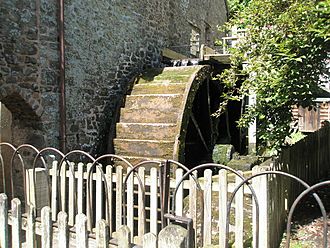Dunster Working Watermill facts for kids
Quick facts for kids Dunster Working Watermill |
|
|---|---|

Waterwheel
|
|
| General information | |
| Town or city | Dunster |
| Country | England |
| Coordinates | 51°10′49″N 3°26′42″W / 51.18030°N 3.4449°W |
| Construction started | 1779 |
| Completed | 1782 |
The Dunster Working Watermill is an old mill that uses water to grind grain. It's also known as Castle Mill. You can find it near the River Avill and Gallox Bridge. This historic mill is located in the beautiful grounds of Dunster Castle in Dunster, Somerset, England.
This special building was built around 1780. It stands on a spot where a mill has been grinding grain for a very long time, even since 1086! The mill stopped working in 1962, but it was fixed up in 1979. Today, it still grinds flour, just like it used to. The mill's machinery is powered by two large waterwheels. The National Trust owns and runs the mill, keeping its history alive.
History of Dunster Mill
Mills have been important in Dunster for a very long time. The first record of a mill here was in the Domesday Book in 1086. At that time, there were two mills in Dunster. The one called the Lower Mill was on the same spot as the mill you see today.
Over the years, the mills changed. In the 1600s, there were mills for grinding malt and oats. By 1721, one of these had even been changed to a fulling mill, which was used to clean and thicken cloth. The current mill building was constructed around 1780. It replaced the two older mills that were there before.
In 1940, a bakery was added to the mill site. The mill continued to grind corn until World War II. After the war, it ground animal feed until it finally closed its doors in 1962.
Mill Restoration and Modern Use
The Dunster Working Watermill was brought back to life in 1979. It was a big project, and the mill even won an award for its restoration in 1982. Today, the mill is still busy! It produces different types of flour, like Wheat, Rye, and Spelt, all from organic grain.
The old wagon house and stables at the mill were turned into a cozy cafe. More restoration work happened in 2007, with help from the Exmoor Sustainable Development Fund.
The National Trust owns the mill. Many people visit it each year, about 60,000 tourists! The mill produces around 10 tonnes of flour every year. In 2015, the second waterwheel was replaced. The machinery connected to it was also fixed and improved in 2016. The three special millstones, which are called French burr millstones, were sharpened in 2024.
How the Mill Works
The Dunster Working Watermill is a three-story building with a slate roof. On one side, there's a stone wall with beautiful wrought iron gates.
The mill uses a clever system to grind grain. It has two large overshot waterwheels. These wheels are turned by the flowing water of the river. As the waterwheels spin, they power other gears inside the mill. These gears include the pit wheel, spur wheel, and stone nut. This whole system then turns the heavy millstones. The millstones are what actually grind the grain into flour.
There are also special trapdoors on the first and second floors. These trapdoors allow sacks of grain to be lifted up to the higher floors using a sack hoist. This makes it easier to move the heavy grain around the mill.
See also
- List of National Trust properties in Somerset


